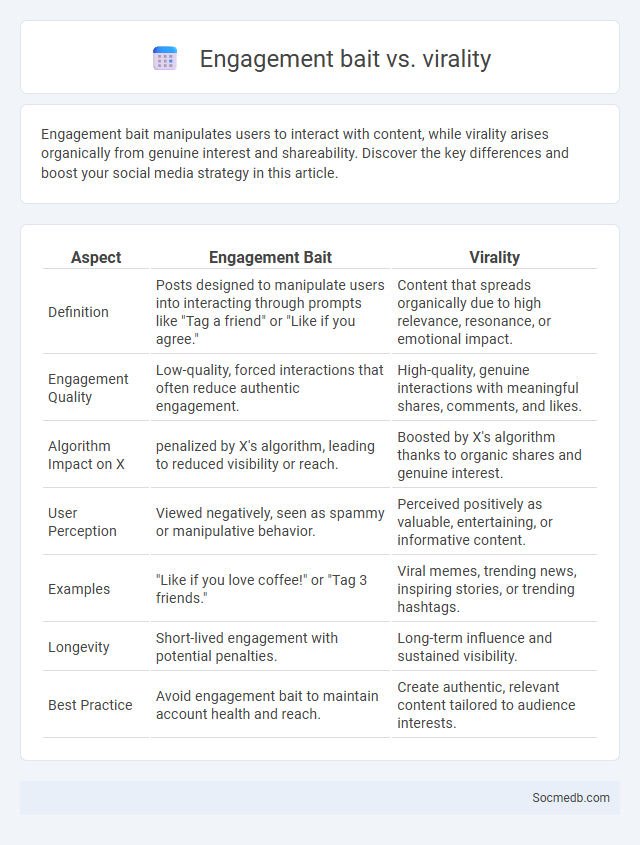
Photo illustration: Engagement bait vs Virality
Engagement bait manipulates users to interact with content, while virality arises organically from genuine interest and shareability. Discover the key differences and boost your social media strategy in this article.
Table of Comparison
| Aspect | Engagement Bait | Virality |
|---|---|---|
| Definition | Posts designed to manipulate users into interacting through prompts like "Tag a friend" or "Like if you agree." | Content that spreads organically due to high relevance, resonance, or emotional impact. |
| Engagement Quality | Low-quality, forced interactions that often reduce authentic engagement. | High-quality, genuine interactions with meaningful shares, comments, and likes. |
| Algorithm Impact on X | penalized by X's algorithm, leading to reduced visibility or reach. | Boosted by X's algorithm thanks to organic shares and genuine interest. |
| User Perception | Viewed negatively, seen as spammy or manipulative behavior. | Perceived positively as valuable, entertaining, or informative content. |
| Examples | "Like if you love coffee!" or "Tag 3 friends." | Viral memes, trending news, inspiring stories, or trending hashtags. |
| Longevity | Short-lived engagement with potential penalties. | Long-term influence and sustained visibility. |
| Best Practice | Avoid engagement bait to maintain account health and reach. | Create authentic, relevant content tailored to audience interests. |
Understanding Engagement Bait: Definition and Examples
Engagement bait refers to social media tactics designed to manipulate users into interacting with content through likes, shares, comments, or tags, often using prompts such as "Like if you agree" or "Tag a friend who needs to see this." Platforms like Facebook and Instagram actively demote posts employing engagement bait to maintain content quality and user experience. Examples include "share if you care," reaction polls, and comment challenges that encourage artificial interaction rather than genuine engagement.
What Is Virality? Key Characteristics
Virality refers to the rapid and widespread sharing of content across social media platforms, driven by high audience engagement and emotional resonance. Key characteristics include shareability, which makes content easily distributable; relatability, enabling users to connect personally; and timing, aligning with current trends or events to maximize visibility. Content that achieves virality often features compelling visuals, concise messaging, and encourages user interaction to amplify reach organically.
Engagement Bait vs. Virality: Core Differences
Engagement bait tactics manipulate social media algorithms by urging You to react, comment, or share through explicit calls to action, often resulting in low-quality interactions and potential platform penalties. Virality emerges organically when content resonates deeply, encouraging genuine shares and interactions driven by emotional or informational value. Understanding these core differences helps You create meaningful content that fosters authentic engagement rather than temporary spikes from engagement bait.
Common Tactics Used in Engagement Bait
Engagement bait on social media commonly involves tactics such as urging users to like, share, comment, or tag friends to increase post visibility and interaction. These strategies exploit platform algorithms by encouraging low-effort engagement through clickbait phrases like "Like if you agree" or "Tag someone who needs to see this." Such methods often lead to diminished content quality and can result in penalties from social media networks aiming to promote authentic user interaction.
The Psychology Behind Virality on Social Media
Understanding the psychology behind virality on social media involves recognizing the emotional triggers that drive sharing, such as humor, awe, or anger. Content that sparks social validation and taps into your desire for connection is more likely to be shared widely. Algorithms amplify posts with high engagement, reinforcing trends and increasing the reach of viral content.
Why Platforms Penalize Engagement Bait
Social media platforms penalize engagement bait because it manipulates algorithms by encouraging low-quality interactions like spammy comments, shares, or reactions that do not foster genuine user engagement. These tactics degrade user experience, reduce content relevance, and can artificially inflate metrics, leading to misleading insights for marketers and creators. Understanding this helps You create authentic content that aligns with platform guidelines and earns organic engagement.
Measuring Success: Virality vs. Engagement Bait
Measuring success on social media requires distinguishing between genuine engagement and engagement bait tactics. Virality driven by authentic content leads to sustainable audience growth, while engagement bait often generates fleeting interaction without building meaningful connections. Your social media strategy should prioritize quality engagement metrics over superficial likes or shares to achieve long-term brand impact.
Real-World Case Studies: Viral Content vs. Engagement Bait
Analyzing real-world case studies reveals that viral content, which naturally resonates with audiences, generates sustained engagement and builds authentic community trust. In contrast, engagement bait tactics--such as urging "like and share" directives--often lead to short-term spikes but can result in diminished reach due to platform penalties. Understanding this distinction helps you create content strategies that foster genuine interactions and long-term social media growth.
Ethical Considerations for Marketers
Marketers must prioritize transparency and honesty when crafting social media campaigns to maintain consumer trust and comply with advertising regulations. Respecting user privacy by obtaining explicit consent before collecting data ensures your brand avoids legal pitfalls and fosters positive engagement. Ethical social media marketing not only protects your reputation but also builds long-term customer loyalty through responsible communication practices.
Best Practices: Driving Genuine Engagement and Virality
Creating authentic content that resonates with the target audience drives genuine engagement on social media platforms. Leveraging user-generated content, interactive features like polls and live videos, and timely responses to comments fosters trust and community growth. Employing data analytics to tailor posts and optimize timing enhances the potential for virality, ensuring content reaches and captivates a broader audience.
 socmedb.com
socmedb.com